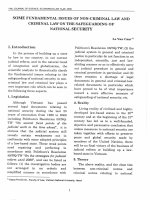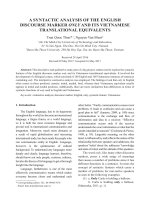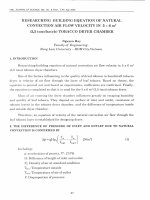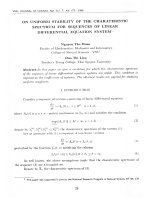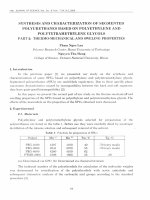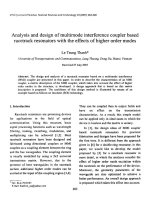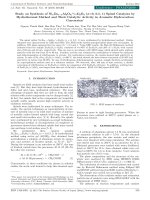DSpace at VNU: Identification by LC-ESI-MS of Flavonoids Responsible for the Antioxidant Properties of Mallotus Species from Vietnam
Bạn đang xem bản rút gọn của tài liệu. Xem và tải ngay bản đầy đủ của tài liệu tại đây (246.89 KB, 7 trang )
982
IEEE TRANSACTIONS ON NEURAL NETWORKS, VOL. 22, NO. 6, JUNE 2011
Efficient Algorithm for Training Interpolation
RBF Networks with Equally Spaced Nodes
Hoang Xuan Huan, Dang Thi Thu Hien, and Huynh Huu Tue
Abstract— This brief paper proposes a new algorithm to train
interpolation Gaussian radial basis function (RBF) networks in
order to solve the problem of interpolating multivariate functions
with equally spaced nodes. Based on an efficient two-phase
algorithm recently proposed by the authors, Euclidean norm
associated to Gaussian RBF is now replaced by a conveniently
chosen Mahalanobis norm, that allows for directly computing
the width parameters of Gaussian radial basis functions. The
weighting parameters are then determined by a simple iterative
method. The original two-phase algorithm becomes a one-phase
one. Simulation results show that the generality of networks
trained by this new algorithm is sensibly improved and the
running time significantly reduced, especially when the number
of nodes is large.
Index Terms— Contraction transformation, equally spaced
nodes, fixed-point, output weights, radial basis functions, width
parameters.
I. I NTRODUCTION
Interpolation of functions is a very important problem
in numerical analysis with a large number of applications
[1]–[5]. The case of 1-D had been studied and solved by
Lagrange, using polynomial as forms of interpolating functions. However, the multivariable problems have attracted
interest of researchers only in the second half of the 20th
century, when pattern recognition, image processing, computer
graphics and other technical problems dealing with partial different equations were born. Several techniques were proposed
to solve the approximation and interpolation problems such as
multiple-layered perceptron, radial basis function (RBF) neural
networks, k-nearest neighbor (K-NN) and locally weighted
linear regression [6]. Among these methods, RBF networks
are commonly used for interpolating multivariable functions.
The RBF approach was first proposed by Powell as an efficient
technique to solve the multivariable function interpolation [7].
Broomhead and Lowe had adapted this method to build and
train neural networks [8].
In a multivariate interpolation RBF network of a function f , the interpolation function is of the form: ϕ(x) =
M
k
k=1 wk h(||x − v ||), σk ) + w0 with interpolation conditions
N
k
k
is a set
ϕ(x ) = y , for all k = 1, . . . , N, where {x k }k=1
of n-dimensional vectors (called as interpolation nodes) and
Manuscript received February 11, 2010; revised February 19, 2011;
accepted February 19, 2011. Date of publication May 13, 2011; date of
current version June 2, 2011. This work was supported in part by the National
Foundation for Science and Technology Development.
H. X. Huan is with the College of Technology, Vietnam National University,
Hanoi, Vietnam (e-mail: ).
D. T. T. Hien is with the University of Transport and Communications,
Hanoi, Vietnam (e-mail: ).
H. H. Tue is with the Bac-Ha International University, Hanoi, Vietnam
(e-mail: ).
Digital Object Identifier 10.1109/TNN.2011.2120619
y k = f (x k ) is a measured value of function f at respective
interpolation node (in approximation networks, these equations
are approximated), real functions h(||x − v k ||, σk ) are called
as RBFs with center v k (M ≤ N), where wk and σk are
unknown parameters that we have to determine. The general
approximation (known as generality property) was discussed
in [9] and [10].
The most common kind of RBFs [2], [11], [12] is of
2
2
Gaussian form h(||x − v||, σ ) = e−||x−v|| /σ , where ν and
σ are, respectively, the center and the width parameters of the
RBFs.
For noiseless data with a small number of interpolation
nodes, they are employed as centers of RBFs such that the
number of nodes is equal to the number of RBFs to be used
(M = N). Given preset widths, the output weights satisfying
the interpolation conditions are unique and the corresponding
RBF networks are called as interpolation ones.
For the case of large number of interpolation nodes, the
Gauss elimination method or other direct methods using
matrix multiplication have the complexity of O N 3 , furthermore, accumulated errors quickly increase. On the other
hand, optimization techniques used to minimize the sum of
squared errors converge too slowly and give large final errors.
Therefore, one often chooses M smaller than N [12]. To
choose the number of neurons M and determine the centers
v k of the corresponding RBFs are still open research problems
[13], [14]. To avoid these obstacles, the authors recently
proposed an efficient algorithm to train interpolation RBF
networks with very large number of interpolation nodes with
high precision and short training time [15], [16].
In practice, like in computer graphics as well as in technical problems involving partial differential equations, for the
interpolation problem, one often has to deal with the case of
equally spaced nodes [1], [3], [5]. This brief paper is based on
the training algorithm proposed by Hoang, Dang, and Huynh
[15], referred from now on as HDH algorithm. This HDH
training algorithm has two phases: 1) in the first, it iteratively
computes the RBF width parameters, and 2) in the second,
the weights of the output layer are determined by the simple
iterative method.
In the case of equally spaced data, their coordinates can be
expressed as x i1,i2,...in = (x 1i1 , . . . , x nin ), where x kik = x k0 +
i k ∗ h k , h k being the constant steps in the k t h dimension and
ik
√ varies from 1 to Nk . When the Euclidian norm ||x|| =
x T x associated
to RBF is replaced by a Mahalanobis norm
√
||x|| A = x T Ax with A conveniently chosen as specified
in Section III-A, by exploiting the characteristic of uniformly
spaced data, the width parameters can now be predetermined
so that the originally proposed technique becomes one-phase
algorithm.
As the training time for the original algorithm is mainly
spent in the first, the obtained one-phase algorithm is therefore very efficient. Furthermore, the generality is sensitively
improved.
The rest of this brief paper is organized as follows. In
Section II, interpolation RBF networks and the HDH algorithm
[15] are briefly introduced. Section III is dedicated to the
new algorithm for the interpolation problem with equally
1045–9227/$26.00 © 2011 IEEE
IEEE TRANSACTIONS ON NEURAL NETWORKS, VOL. 22, NO. 6, JUNE 2011
spaced nodes. Simulation results are shown in Section IV.
Some conclusions are presented in the final section.
II. I NTERPOLATION RBF N ETWORKS AND THE HDH
A LGORITHM
This section briefly presents the HDH algorithm and its
related concepts (see [15] for more details).
A. Interpolation RBF Network
Multivariate Interpolation Problem: Consider the problem of interpolation with noiseless data. Let f be a multivariate function f : D(⊂ R n ) → R m and the sample
N ; {x k } N
k
k
set{x k , y k }k=1
k=1 ⊂ D such that f (x ) = y ; k =
1, . . . , N. Let ϕ be a function of a known form satisfying
ϕ(x i ) = y i
∀i = 1, . . . , N.
(1)
The points x k and the function ϕ are, respectively, called as
interpolation nodes and the interpolation function of f . ϕ is
used to approximate f on the domain D. Powell proposed
to exploit RBFs for the interpolation problem [7]. In the
following section, we will sketch the Powell technique using
Gaussian radial function (for further details see [12], [17]).
Interpolation Technique Based on RBFs: Without loss of
generality, it is assumed that m is equal to 1. The interpolation
function ϕ has the following form:
N
wk ϕk (x) + w0
ϕ(x) =
(2)
983
Furthermore, determining the optimum center is still an open
research problem as mentioned above.
Interpolation RBF Network Architecture: An interpolation
RBF network is a 3-layer feedforward neural network which
is used to interpolate a multivariable real function f : D(⊂
R n ) → R m . It is composed of n nodes of the input layer,
represented by the input vector x ∈ R n ; there are N neurons
in the hidden layer, of which the kth neuron center is the interpolation node x k and; its kth output is ϕk (x); finally the output
layer contains m neurons which determine interpolated values
of f (x). Given the fact that in the HDH algorithm, each neuron
of the output layer is trained independently when m > 1,
we can then assume m = 1 without loss of generality. There
are different training methods for interpolation RBF networks,
but as shown in [15], the HDH algorithm offers the best-known
performance (with regard to training time, training error and
generality) and is briefly presented in the following section.
B. Review of the HDH Algorithm
In the first phase of the two-phase HDH algorithm, radial
parameters σk are determined by balancing between the error
and the convergence rate. In the second phase, weight parameters wk are obtained by finding the fixed point of a given
contraction transformation accordingly selected. Let us denote
by Section I the N × N identity matrix, W = [w1 , . . . , w N ]T ,
Z = [z 1 , . . ., z N ]T , respectively, two vectors in N-dimensions
space R N , where
z k = yk − w0 ∀k ≤ N
k=1
where
ϕk (x) = e−
x−x k
2
/σk2
; ∀k = 1, . . . , N
(3)
where u is a norm of u (in this brief paper, it is the Euclidean
norm) and x k is called as center of RBF ϕk , wk and σk , are
parameters such that ϕ satisfying interpolation conditions (1)
ϕ(x i ) =
and let
=I−
where
wk ϕk (x i ) + w0 = y k ; ∀i = 1, . . . , N.
= ψk, j
N×N
(7)
is given in (5), then
ψk, j =
N
(6)
(4)
0;
if : k = j
j
k 2
2
−e−||x −x || /σk ; if : k = j.
(8)
Equation (2) can now be rewritten as
k=1
For each k, parameter σk (called width parameter of RBF)
is used to control the width of the Gaussian basis function
ϕk , when x − x k > 3σk , then ϕk (x) is almost negligible.
Consider the N × N matrix
= ϕk,i
W=
ϕk,i = ϕk (x i ) = e
(9)
w0 in (3) is chosen as the average of y k values. Now, for each
k ≤ N, let us define qk > q with
N
N×N
where
W+Z
ψk, j .
qk =
−||x i −x k ||2
σk2
j =1
(5)
with the chosen parameters σk . If all nodes
are pairwise
different, then the matrix is positive-definite [18]. Therefore,
with given w0 , the solution w1 , . . . , w N of (2) always exists
and is unique.
In the case where the number of RBFs is less than N,
their center might not be an interpolation node and (2) may
not have any solution, the problem is then finding the best
approximation of f using any optimum criteria. Usually,
parameters wk and σk are determined by the least mean square
method [12], which does not correspond to our situation.
xk
Given an error ε and two positive constants q < 1 and
α < 1, the algorithm computes parameters σk and W ∗ , solution
of (9). In the first phase, for each k ≤ N, σk is determined such
that qk < q, while replacing σk by σk /α, we have qk > q.
given by (6)
With these values, the norm ψ ∗ of matrix
is less than q, such that an approximate solution W ∗ of (9)
will be found in the next phase by a simple iterative method.
The norm of N-dimension vector u is given by
u
∗
= max
uj
≤N .
j
(10)
984
IEEE TRANSACTIONS ON NEURAL NETWORKS, VOL. 22, NO. 6, JUNE 2011
The ending condition is chosen by the following:
q
W 1 − W 0 ≤ ε.
∗
1−q
efficient algorithm. Equations (1) and (3) are then rewritten as
follows:
(11)
N1 ,...Nn
W1 − W∗
∗
≤ ε.
wi1,...in ϕi1,...in (x) + w0
ϕ(x) =
The above algorithm always ends after a finite number of
steps, of which the solution satisfies the following inequality:
where
ϕi1,...in (x) = e−
(12)
Its complexity is O (T + c) n N 2 , where c and T are given
constants [15]. The training time of phase 1 only depends
on the number of interpolation nodes and that of phase 2 on
N
yi | but not on the variation
Z ∗ = max |Z i = y i − 1/n i=1
of the interpolated function f .
A nice feature of the HDH algorithm is that it computes
the RBFs widths in such a way that the matrix to be used
in the second phase is of diagonal dominance, which is the
desired property that allows for a very efficient determination
of the output weights by the simple iterative method. Due to
this efficiency, the HDH algorithm can handle interpolation
networks with a very large number of nodes.
Experimental results show that the first phase of the HDH
algorithm consumes a high percentage of the total running time
(see Section IV-A below). The objective of this brief paper
is to precompute these RBF widths for the case of equally
spaced nodes so that the HDH algorithm will become onephase algorithm.
A. Problem with Equally Spaced Nodes
From now on, we consider a problem that the interpolation
nodes are equally spaced. In these cases, we can express each
interpolation node by a multi-index node as
.
(15)
The N × N matrix expressed in (5) is rewritten as:
j 1,..., j n
ϕi1,...,in
(N = N1 . . . Nn ), where
=
N×N
ϕi1,...,in = ϕi1,...in (x j 1,..., j n ) = e−
x j 1,..., j n −x i1,...in
j 1,..., j n
j 1,..., j n
i1,...,in
=
2
2
A /σi1,...in
.
(16)
are defined as follows:
= I−
0; if : j 1, . . . , j n = i 1, . . . , 1n
−e−
x j 1,..., j n −x i1,...,in
2
2
A /σi1,...,in
.
(17)
Radii σi1,...,in are determined so that matrix is a contraction transformation, in order to ensure that the phase two of
the HDH algorithm can be correctly applied.
It means that, given a constant q ∈ (0, 1), choose σi1,...,in
such that
j 1,..., j n
ψi1,...,in
qi1,...,in =
≤ q < 1.
(18)
j 1,..., j n
Taking (14) into account, it implies that
⎧
⎪
⎨0, where : j 1, . . . , j n = i 1, . . . , i n
j 1,..., j n
n
h2
=
2
−
( j p−ip)2 2p /σi1,...,in
i1,...,in
⎪
ap
⎩−e p=1
.
(19)
Then, qi1,...,in can be re-written as follows:
n
−
qi1,...,in =
( j p−ip)2
p=1
e
h 2p
a 2p
2
/σi1,...,in
j 1,..., j n=i1,...,in
x i1,i2,...in = (x 1i1 , . . . , x nin ); x kik = x k0 + i k ∗ h k ;
k = 1, . . . , n
2
/σ 2
A i1,...in
x−x i1,...in
The entries of the Matrix
III. I NTERPOLATION P ROBLEM WITH E QUALLY S PACED
N ODES AND N EW T RAINING A LGORITHM
(14)
i1,...in=1
n
(13)
where h k (k = 1, . . . , n) is the changing step of parameter x k ,
n is the number of dimensions, i k are taken in range between 1
and Nk (Nk are scale numbers of the kth dimension).
In (3), the values of each radial function are the same at
points which are equidistant to the center, and its level surfaces
are spherical. This choice does not conveniently suit situations
where interpolation steps {h k ; k = 1, . . . , n} strongly deviate
from each other. In these cases, instead of Euclidean
√ norm,
we consider a Mahalanobis norm defined by x A = x T Ax,
where A is a diagonal matrix
⎛1
⎞
0 ... 0
a12
⎜
⎟
1
⎜0
... 0 ⎟
2
⎜
⎟.
a
A=⎜
2
⎟
⎝ ... ... . ....⎠
0
0 ... a12
Np
−
=
e
( j p−ip)2
− 1.
(20)
p=1 j p=1
Finally, if we set a p = h p , then
n
2
Np
qi1,...,in =
e
− ( j2p−i p)
σi1,...,in
− 1.
(21)
p=1 j p=1
The following theorem is the basis of the new algorithm.
Theorem 6: For all q ∈ (0, 1), if all σi1,...,in are chosen
such that
6
σi1,...,in ≤ ln √
n
1+q −1
− 12
then qi1,...,in < q < 1.
(22)
Proof: In fact, with j p , i p ∈ 1, . . . , N p , the right-hand
side member (RHS) of (21) can be bounded by
n
ak are fixed positive parameters which will be conveniently
chosen later on, in order to allow for constructing our proposed
h 2p
a2
σ2
i1,...,in p
∞
qi1,...,in < 1 + 2
−
e
k=1
k2
σ2
.
i1,...,in
n
− 1.
(23)
IEEE TRANSACTIONS ON NEURAL NETWORKS, VOL. 22, NO. 6, JUNE 2011
985
TABLE I
C OMPARISON OF T RAINING T IME OF N ETWORKS
Procedure QHDH Algorithm
Begin
Setting σi1,..,in = σ// chosen among Eqs (28), (29);
Find W* by simple iterative method;// The same
phase 2 of HDH Algorithm described in section II;
End
Fig. 1.
Number of Nodes
QHDH
HDH
1071 ( N1 = 51, h 1 = 0.2, N2 = 21, h 2 = 1)
5271 (N1 = 251, h 1 = 0.04, N2 = 21, h 2 = 1)
10 in
32 in
275 in
1315 in
10251(N1 = 201, h 1 = 0.05, N2 = 51, h 2 = 0.4)
765 in
> 2h
Procedure of training RBF network with equally spaced nodes.
TABLE II
C OMPARISON OF T RAINING E RROR AND T RAINING T IME OF N ETWORKS
(a)
(b)
Fig. 2.
Influence of RBFS with star as center. (a) Euclidean norm.
(b) Mahalanobis norm.
Test
Function
A sufficient condition to insure (18) is
∞
−
1+2
e
Y2
n
k2
σ2
.
i1,...,in
− 1 ≤ q < 1.
Average
Error
QTH σ =
0.07252
SSE =
0.0013856
Training
Time =
48 in
Average
Error
QTL σ =
0.07215
SSE =
0.0016743
Training
Time =
46 in
Average
Error
7.84E-08
6.95E-05
7.16E-05
QHDH,
q = 0.9
σ = 0.5568
Training
Time =
18 in
HDH,
q = 0.9
α = 0.9
Training
Time =
35 in
Average
Error
3.85E-09
(24)
k=1
That is equivalent to
∞
−
e
k2
2
σi1,...,in
.
≤
√
n
k=1
1+q −1
.
2
(25)
To simplify the notation, let us denote σi1,...,in by σ . Given
the condition that q < 1 and n ∈ N, the RHS of (25) is all the
time upper-bounded by 1/2. Let us consider just the first term
of the left-hand side member (LHS) of (25). We then have
1
1
.
(26)
, that gives σ < √
2
ln 2
On the other hand, the LHS of (25) can be bounded as
follows:
e
∞
2
e
− k2
σ
=e
−
−
1
σ2
<
∞
1
σ2
k=1
e
−k
2 −1
σ2
=e
−
∞
1
σ2
1+
k=1
=e
−
∞
1
σ2
1+
e
2
− (k+1)2 −1
σ
k=1
⎛
−
1
σ2
−
e
2
− t2
σ
−k
k=2
∞
1
σ2
1+
2 −1
σ2
dt ⎠ = e
−
1
σ2
−
k2
σ2
k=1
−
1
σ2
1+
π/ log(1)
2
π
2
.
−
1
σ2
< 3e
−
1
σ2
.
(27)
(27) shows that (25) is satisfied when
2
√
3e−1/σi1,...,in ≤ ( n 1 + q − 1)/2 or equivalently, (25) is
satisfied when
Equation
1
σi1,...,in ≤
ln
6
√
n 1+q−1
.
.
(28)
2) With given n, q and γ > 1 choosing σ = σ0 γ m , where
m is the largest integer such that
√
N
2
n
1+q −1
− k2
.
(29)
e σ ≤
2
k=1
In this case, using the same approach as in (21)–(24), it is
easy to show that (22) is satisfied. The complexity is of the
order O(N), which is almost negligible, compared to other
orders.
B. New Training Algorithm QHDH
1+σ
≈ 2.085e
− 12
σ
0
e
6
1+q −1
− k2
Using (26), we obtain
∞
σi1,...,in
= σ0 = ln √
n
2
e
k=1
⎞
∞
⎝1 +
e
Remark 8: For practical purpose, it is more convenient to
choose all σi1,...,in identical and equal to σ with two different
possibilities.
1)
Now, with given positive constant q<1, parameters σi1,...,in
are preset by one of the three possible choices defined in
(28) and (29). Based on the above theorem, the output layer
weights can be determined by using the second phase of the
HDH algorithm. Thus, the new algorithm is named as QHDH
(abbreviation of Quick HDH) which is specified in Fig. 1.
C. Algorithm Complexity
The complexity of this algorithm is due to two actions:
computing
and computing the output weights. The complexity associated to the computation of
is O(n N 2 ). To
compute the output weights warranting a given error ε, we
need at most T iterations with T = (ln(ε(1 − q)/ Z ∗ )/ ln q)
[15], each iteration has the complexity O(N 2 ) so that the total
complexity of the algorithm is O((n + T )N 2 ).
986
IEEE TRANSACTIONS ON NEURAL NETWORKS, VOL. 22, NO. 6, JUNE 2011
D. Discussion on the Algorithm
One good feature of Gauss RBF neural networks is their
local character, meaning that only data in their neighborhood
can influence their behavior (see [6]). For this reason it
is suggested to choose small width for RBFs [19, p.289].
However, for points far away from the center, values of RBFs
are negilible so that the interpolation errors at these points
become inacceptable. This behavior is illustrated in Fig. 2(a).
The following experiments show that the width chosen by our
method gives better performance when compared to Haykin
or Looney choices
√ [12], [17]. Moreover, with the Mahalanobis
norm x A = x T Ax defined in Section III-A, with any
h k , points far from centers are still strongly influenced by
RBFs [see Fig. 2(b)]. Thank to this property, the generality of
the networks when using the Mahalanobis norm offers better
performance compared to Euclidean norm. These features are
in fact observed in following simulation results.
IV. S IMULATION S TUDY
In [15], the complexity and the convergence of the HDH
algorithm have been analyzed, as the QHDH algorithm is a
sibling of the HDH one, it still has all advantages of the HDH
one. The goal of the following simulations is to compare
the training time, training error and the generality of the
networks trained by the QHDH algorithm with respect to those
trained by the HDH algorithm and some one-phase gradient
algorithms.
In the scenarios of simulation, we are interested in comparing the running time, the training error and the generality
of QHDH, HDH [15], LMS/SSE [12, pp.98–100] with two
1/n [12,
different choices of width
√ parameters σ = 1/(2N)
p.99] and (σ = D max/ 2N ) [17, p.299], where Dmax is the
maximum distance between two interpolation nodes. In the
following, the last two algorithms are denoted as QTL and
QTH. To avoid repetition, we only present numerical results
for the case where σ is defined by (28).
Given the fact that the QHDH running time linearly depends
on the data space dimensions, for the simulation convenience,
we just need low dimension spaces to illustrate its performance. On the other hand, the performance of QHDH and
HDH are perfectly determined so that for the convenience
of comparison, to avoid the burden of presentation, we just
look at 10 randomly chosen points farthest from centers in
the interpolation domain for the interpolation error.
Noiseless data are generated with four different functions.
The first function with two-variables y1 = 1 + (2x 1 +
cos(3x 1)) /(x 1 x 2 + 1) where x 1 ∈ [0, 3.5] and x 2 ∈ [0, 7]
provide a case where different numbers of interpolation nodes
are used to compare the training time with respect to the HDH
algorithm.
The last three ones of three-variables
y2 = x 1 + cos (x 2 + 1) + sin(x 3 + 1) + 2,
x 1 ∈ [0, 1] , x 2 ∈ [0, 2] , x 3 ∈ [0, 3]
y3 = x 12 x 2 + sin (x 2 + x 3 + 1) + 1,
x 1 ∈ [0, 1] , x 2 ∈ [0, 2] , x 3 ∈ [0, 3]
y4 = x 12 x 2 + x 3 + sin (x 2 + x 3 + 1) + 1,
x 1 ∈ [1, 2] , x 2 ∈ [0, 2] , x 3 ∈ [0, 3]
give more complex cases to be studied, in order to illustrate
the performance of the QHDH algorithm. We are going to
compare the training error and the network generality of
QHDH with respect to the ones of HDH algorithm, the QTL
algorithm and the QTH algorithm. Furthermore, comparing the
algorithm generality for different choices of σ will show the
best choice for the training process.
The tests are run on a computer with the following configuration: on Intel Pentium IV Processor, 3.0 GHz, and 512 MB
DDR RAM. The ending condition is the error ε = 10−6 .
A. Comparison of Training Time
The simulation results are presented in Table I for the twovariable function in order to compare training time of networks
trained by the QHDH algorithm and by the HDH algorithm.
The training time of networks trained by the QHDH
algorithm is reduced significantly in comparison to those of
networks trained by the HDH algorithm.
B. Comparison of Training Error
The experiment results are presented in Table II for the
three-variable function y2 with 1331 nodes, where N1 = 11,
h 1 = 0.1; N2 = 11; h 2 = 0.2; N3 = 11; h 3 = 0.3. After the
training is completed, the average training error is computed
over 100 randomly chosen interpolation nodes.
The experiment results have shown that the training error
and the training time of the QHDH algorithm are the best
among these four algorithms.
C. Comparison of Generality
The network generality trained by different algorithms is
analyzed for two cases by computing errors: 1) at 10 points
which are farthest ones from interpolation nodes, and 2) at
100 random points using cross validation method [20].
1) Comparison at the Farthest Points: The experiment
results are presented in Table III for the three-variable function
y2 with 1331 nodes, where N1 = 11, h 1 = 0.1, N2 = 11,
h 2 = 0.2, N3 = 11, h 3 = 0.3. After the training is finished,
we take 10 random points which are the farthest ones from
interpolation nodes in the interpolated domain.
The experiment results have shown that the QHDH algorithm has a runtime much shorter and its generality much
better than those trained by other algorithms.
2) Comparison by Cross-Validation: In this section, we are
going to compare the average absolute error computed over
100 randomly chosen nodes, namely the cross-validation error,
for the three training methods: QHDH, QTL, and QTH for all
four functions with σ = γ m σ0 , where γ = 1.1 and m ≥ −1.
Table IV shows the cross-validation error corresponding to
the two-variable function y1 with 1296 interpolation nodes
and with N1 = N2 = 36, h 1 = 0.1, h 2 = 0.2. Table V
shows results for three other functions y2 , y3 and y4 with 1331
interpolation nodes with N1 = N2 = N3 = 11, h 1 = 0.1,
h 2 = 0.2, h 3 = 0.3.
IEEE TRANSACTIONS ON NEURAL NETWORKS, VOL. 22, NO. 6, JUNE 2011
987
TABLE III
C OMPARISON OF G ENERALITY OF N ETWORKS AT 10 FARTHEST P OINTS
Original
Function
Value
Co-ordinate of
Checked Point
x1
QHDH: q = 0.9,
σ = 0.5568 Training
Time = 18 in
Interpolation
Error
Value
QTH: σ = 0.07252,
SSE = 0.0013856
Training Time = 48 in
Interpolation
Error
Value
HDH: q = 0.9, α = 0.9
Training Time = 35 in
Interpolation
Value
x2
x3
0.25 1.1
0.2
2.67719298
2.61873
0.058462981
2.587851
0.0893423
0.108851
2.568342
0.298539
2.378654
0.45 0.9
0.4
3.11216016
2.97086
0.141300163
3.325614
0.2134542
0.237326
2.874834
0.424728
2.687432
0.35 1.3
0.5
2.68121897
2.61761
0.063608965
2.602756
0.0784632
0.493676
2.187543
0.462473
2.218746
0.15 0.9
1
2.73600786
2.65512
0.08088786
2.82574
0.0897323
0.640525
2.095483
0.53864
2.197368
0.45 1.1
1.3
2.69085911
2.63282
0.058039108
2.612116
0.0787432
0.561016
2.129844
0.360984
2.329875
0.25 1.3
1.6
2.09922535
2.28295
0.183724649
2.249048
0.1498224
0.223732
1.875493
0.204642
1.894583
0.35 0.7
2.1
2.26273617
2.34536
0.082623832
2.361169
0.0984326
0.07928
2.183456
0.049862
2.212875
0.45 0.9
1.9
2.36595976
2.44444
0.078480238
2.463603
0.0976436
0.217583
2.148377
0.078399
2.287561
0.65 0.7
1.7
2.94853539
2.7636
0.184935386
3.146968
0.1984324
0.60088
2.347655
0.420098
2.528438
0.75 0.9
1.9
2.66595976
Average error
2.62388
0.042079762
2.578279
0.0876803
0.833472
1.832488
0.183307
0.097414294
Error
QTL: σ = 0.07215
SSE = 0.0016743
Training Time = 46 in
Interpolation
Error
Value
0.1181747
2.224351
2.482652
2.321818
TABLE IV
C OMPARISON OF G ENERALITY OF N ETWORKS AT 100 R ANDOM P OINTS FOR Y1
Test
Function
Y1
σ = 0.546818
σ = 0.6015
σ = 0.66165
σ = 0.7218
σ = 0.79398
QTH:
σ = 0.1537218
SSE = 0.001552
Average Error
Average Error
Average Error
Average Error
Average Error
Average Error
Average Error
0.0932212
0.0512532
0.025595
0.0152543
diverging
1. 583921
5. 548693
QHDH, q = 0.9
QTL:
σ = 0.0196419
SSE = 0.00174
TABLE V
C OMPARISON OF G ENERALITY OF N ETWORKS AT 100 R ANDOM P OINTS F OR Y2 , Y3 AND Y4
σ = 0.5568
σ = 0.61248
σ = 0.66816
σ = 0.734976
QTH:
σ = 0.07252
SSE = 0.0013856
Average Error
Average Error
Average Error
Average Error
Average Error
Average Error
Average Error
0.10701
0.0677356
0.0375895
0.0192477
diverging
2.0143854
2.1349864
Y3
0.11147
0.0708092
0.0392766
0.0202813
diverging
2.1013045
2.1835982
Y4
0.23456731
0.0851456
0.0813783
0.0787494
diverging
2.158693
2. 2178432
Test
Function σ = 0.50618
Y2
QHDH, q = 0.9
From experimental results we can conclude that networks
trained by the QHDH algorithm offer much better performance
than trained by the QTH algorithm and by the QTL algorithm.
Furthermore, it is observed that when σ increases, under the
constraint defined by (29), the interpolation network generality
is improved.
V. C ONCLUSION
The HDH algorithm for training interpolation RBF networks
presented in [15] improves significantly the quality of networks. On the other hand, in cases of equally spaced nodes, it
does not exploit any advantage of this uniform distribution
of nodes. By replacing Euclidean norm in Gaussian radial
functions by an appropriately chosen Mahalanobis norm, we
can conveniently preset the width parameters, and then use
the second phase of the HDH algorithm to train interpolation
QTL:
σ = 0.07215459
SSE = 0.0016743
networks. This new one-phase algorithm does not only reduce
seriously the networks training time but also improves significantly the network generality. Simulation results show that
the QHDH is really powerful when applied to problems with
large number of interpolation nodes.
In practice, for arbitrarily distributed nodes of noisy data,
the approximation problem might be solved by the following
approach. The first step is to construct an appropriate uniform
grid and at the nodes of this newly formed grid, the values
of the target approximation function are computed by the
linear regression technique applied to their K-NN points.
Finally the interpolation RBF networks can be constructed
in applying the QHDH algorithm over this new uniform
grid.
One last interesting point to be mentioned is that in a
recent research work [20], a kind of “optimum” choice for
988
IEEE TRANSACTIONS ON NEURAL NETWORKS, VOL. 22, NO. 6, JUNE 2011
the RBF parameters is proposed; but its complexity is O(N 3 ).
Our proposed method, while not optimum in any sense, has
the complexity O(N 2 ). This is why for large size problems,
our algorithm is up to now the only one that can handle the
situation.
R EFERENCES
[1] R. H. Bartels, J. C. Beatty, and B. A. Barsky, An Introduction on Splines
for Use in Computer Graphics & Geometric Modeling. San Mateo, CA:
Morgan Kaufmann, 1987.
[2] E. Blanzieri, “Theoretical interpretations and applications of radial basis
function networks,” Inf. Telecomun., Univ. Trento, Trento, Italy, Tech.
Rep. DIT-03-023, 2003.
[3] M. D. Buhmann, Radial Basis Functions: Theory and Implementations.
Cambridge, U.K.: Cambridge Univ. Press, 2004.
[4] R. S. Buss, 3-D Computer Graphics: A Mathematical Introdution with
OpenGL. Cambridge, U.K.: Cambridge Univ. Press, 2003.
[5] P. J. Olver, “On multivariate interpolation,” Studies Appl. Math., vol.
116, no. 2, pp. 201–240, Feb. 2006.
[6] T. M. Mitchell, Machine Learning. New York: McGraw-Hill, 1997.
[7] J. D. Powell, “Radial basis function approximations to polynomials,” in
Proc. Numer. Anal., Dundee, U.K., 1987, pp. 223–241.
[8] D. S. Bromhead and D. Lowe, “Multivariable functional interpolation
and adaptive networks,” Complex Syst., vol. 2, no. 3, pp. 321–355, 1988.
[9] J. Park and I. W. Sandberg, “Approximation and radial-basis-function
networks,” Neural Comput., vol. 5, no. 2, pp. 305–316, Mar. 1993.
[10] T. Poggio and F. Girosi, “Networks for approximating and learning,”
Proc. IEEE, vol. 78, no. 9, pp. 1481–1497, Sep. 1990.
[11] E. Hartman, J. D. Keeler, and J. M. Kowalski, “Layered neural networks with Gaussian hidden units as universal approximations,” Neural
Comput., vol. 2, no. 2, pp. 210–215, 1990.
[12] C. G. Looney, Pattern Recognition Using Neural Networks: Theory and
Algorithm for Engineers and Scientist. New York: Oxford Univ. Press,
1997.
[13] M. Bortman and M. A. Aladjem, “A growing and pruning method for
radial basis function networks,” IEEE Trans. Neural Netw., vol. 20, no.
6, pp. 1039–1045, Jun. 2009.
[14] J. P.-F. Sum, C.-S. Leung, and K. I.-J. Ho, “On objective function,
regularizer, and prediction error of a learning algorithm for dealing with
multiplicative weight noise,” IEEE Trans. Neural Netw., vol. 20, no. 1,
pp. 124–138, Jan. 2009.
[15] H. X. Huan, D. T. T. Hien, and H. T. Huynh, “A novel efficient two-phase
algorithm for training interpolation radial basis function networks,”
Signal Process., vol. 87, no. 11, pp. 2708–2717, Nov. 2007.
[16] D. T. T. Hien, H. X. Huan, and H. T. Huynh, “Multivariate interpolation
using radial basis function networks,” Int. J. Data Mining, Model.
Manage., vol. 1, no. 3, pp. 291–309, Jul. 2009.
[17] S. Haykin, Neural Networks: A Comprehensive Foundation, 2nd ed.
Englewood Cliffs, NJ: Prentice-Hall, 1999.
[18] C. A. Micchelli, “Interpolation of scattered data: Distance matrices and
conditionally positive definite functions,” Const. Approx., vol. 2, no. 1,
pp. 11–22, 1986.
[19] M. H. Mousoun, Fundamental of Artificial Neural Networks. Cambridge,
MA: MIT Press, 1995.
[20] G. E. Fasshauer and J. G. Zhang, “On choosing ‘optimal’ shape
parameters for RBF approximation,” Numer. Algorith., vol. 45, nos. 1–4,
pp. 345–368, 2007.
Embedded Feature Ranking for Ensemble
MLP Classifiers
Terry Windeatt, Rakkrit Duangsoithong, and Raymond Smith
Abstract— A feature ranking scheme for multilayer perceptron
(MLP) ensembles is proposed, along with a stopping criterion
based upon the out-of-bootstrap estimate. To solve multi-class
problems feature ranking is combined with modified errorcorrecting output coding. Experimental results on benchmark
data demonstrate the versatility of the MLP base classifier in
removing irrelevant features.
Index Terms— Classification, multilayer perceptrons, pattern
analysis, pattern recognition.
I. I NTRODUCTION
Whether an individual classifier or an ensemble of classifiers
is employed to solve a supervised learning problem, finding
relevant features for discrimination is important. Most previous
research on feature relevancy has focussed on individual classifiers, but in this brief the issue is addressed for an ensemble
of multilayer perceptron (MLP) classifiers. The extension of
feature relevancy to classifier ensembles is not straightforward,
because of the inherent trade-off between accuracy and diversity [1]. The trade-off has long been recognised, and arises
because diversity must decrease as base classifiers approach
the highest levels of accuracy. There is no consensus on the
best way to measure ensemble diversity, and the relationship
between irrelevant features and diversity is not known.
Feature relevancy is particularly important for small sample
size problems, that is when the number of patterns is fewer
than the number of features [2]. With tens of features in the
original set, feature selection using an exhaustive search is
computationally prohibitive. Since the problem is known to
be NP-hard [3], a greedy search scheme is required, and filter,
wrapper and embedded approaches have been developed [4].
The advantage of an embedded method is that feature selection
is inherent in the classifier itself, and there is no reliance upon
a measure that is independent of the classifier.
Feature ranking is conceptually one of the simplest search
schemes for feature selection, and has the advantage of
scaling up to hundreds of features. Uni-dimensional featureranking methods consider each feature in isolation, but are
disadvantaged by the implicit orthogonality assumption [4],
whereas multi-dimensional methods consider correlations with
remaining features. In this brief, we propose an ensemble of
MLP classifiers that incorporates multi-dimensional feature
ranking based on MLP weights. The ensemble contains a
simple parallel multiple classifier system (MCS) architecture
with homogenous MLP base classifiers.
It is generally believed that MLP weights in a single
classifier are not suitable for identifying relevant features [5].
Manuscript received November 9, 2010; revised March 24, 2011; accepted
March 27, 2011. Date of publication May 13, 2011; date of current version
June 2, 2011. This work was supported in part by the U.K. Government,
Engineering and Physical Sciences Research Council, under Grant E061664/1.
The authors are with the Centre for Vision Speech and Signal Processing, Faculty of Electronics and Physical Sciences, University of Surrey, Guildford Surrey GU2 7XH, U.K. (e-mail: ;
; ).
Digital Object Identifier 10.1109/TNN.2011.2138158
1045–9227/$26.00 © 2011 IEEE
